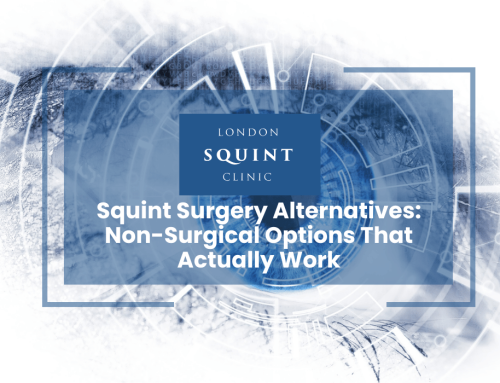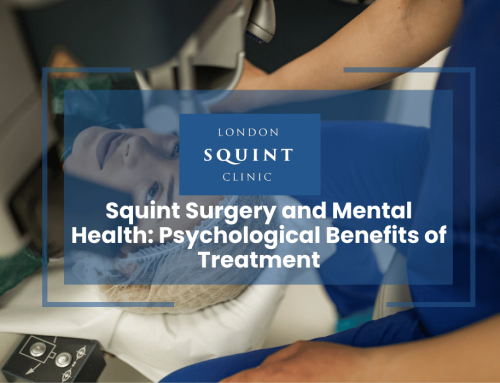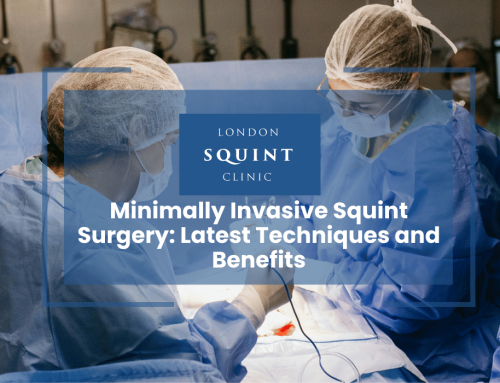Esotropia vs. Exotropia: What Type of Squint Do You Have?
Esotropia vs. Exotropia
- Esotropia vs. Exotropia: Esotropia involves inward eye turning (toward the nose) while exotropia involves outward eye turning (away from the nose).
- Causes vary by age: In children, squints often relate to refractive errors, neurodevelopmental issues, or genetic factors; in adults, they may result from decompensation of childhood squints, neurological conditions, or trauma.
- Early diagnosis is crucial: Recognizing the distinctive signs of each squint type helps ensure timely intervention, particularly important for preventing permanent vision problems in children.
- Treatment is personalized: Options range from non-surgical approaches (glasses, patching, exercises) to surgical procedures, with the specific approach depending on squint type, cause, and severity.
- Prognosis is generally good: With appropriate treatment, most patients achieve improved eye alignment and functional vision, though some may require ongoing management.
Esotropia vs. Exotropia: What Type of Squint Do You Have?
Understanding the specific type of squint (strabismus) affecting you or your child is crucial for effective treatment. Squints are common eye alignment disorders that can affect both children and adults, with esotropia and exotropia being the two most prevalent forms. At London Squint Clinic, we regularly assess and treat patients with various forms of strabismus, helping to restore proper eye alignment and binocular vision.
Whether your eyes turn inward (esotropia) or outward (exotropia), each condition requires a tailored approach to treatment. This comprehensive guide will help you understand the key differences between these squint types, their causes, symptoms, and the various treatment options available at our London facility. Early diagnosis and intervention are particularly important for children, as untreated squints can lead to permanent vision problems including amblyopia (lazy eye) and impaired depth perception.
Table of Contents
- Understanding Squint Types: Esotropia and Exotropia Explained
- What Causes Different Types of Squints in Children and Adults?
- Recognizing the Signs: How to Identify Esotropia vs Exotropia
- Diagnostic Approaches for Accurately Assessing Squint Types
- Treatment Options for Esotropia: From Glasses to Surgery
- Managing Exotropia: Intermittent and Constant Forms
- Squint Surgery Procedures: What to Expect for Each Type
- Long-term Outlook: Recovery and Vision Development
Understanding Squint Types: Esotropia and Exotropia Explained
Squint, medically known as strabismus, occurs when the eyes are not properly aligned. This misalignment results in one eye looking straight ahead while the other turns in a different direction. The two primary types of horizontal squints are esotropia and exotropia, which differ fundamentally in the direction of eye deviation.
Esotropia (convergent squint) is characterised by an inward turning of one or both eyes toward the nose. This inward deviation can be constant or intermittent and may affect one eye consistently (unilateral) or alternate between both eyes. Esotropia is the most common form of squint in children, often developing in early childhood. When it occurs in infants under six months, it’s termed infantile esotropia.
Exotropia (divergent squint) involves an outward turning of one or both eyes away from the nose. Unlike esotropia, exotropia is more commonly intermittent, particularly in its early stages. Many patients with exotropia notice that their eye turns outward when they’re tired, unwell, or daydreaming. Intermittent exotropia may progress to become constant if left untreated.
It’s important to understand that while all forms of esotropia and exotropia are types of strabismus, not all strabismus conditions are horizontal deviations. Vertical deviations (hypertropia and hypotropia) and torsional deviations can also occur, sometimes in combination with horizontal squints. The distinction between these types is crucial for proper diagnosis and treatment planning.
What Causes Different Types of Squints in Children and Adults?
The underlying causes of esotropia and exotropia can vary significantly between children and adults, and understanding these causes is essential for effective treatment.
Causes of Esotropia
In children, particularly infants, esotropia may develop due to:
- Accommodative factors: Significant long-sightedness (hypermetropia) can cause the eyes to over-focus and consequently turn inward. This type, known as accommodative esotropia, typically develops between ages 2-4 years.
- Neurodevelopmental issues: Infantile esotropia, appearing before 6 months of age, may relate to incomplete neuromuscular development.
- Genetic factors: Family history plays a significant role, with children of parents who had squints being more likely to develop one.
- Cranial nerve abnormalities: Conditions affecting the 6th cranial nerve can limit outward eye movement, resulting in esotropia.
In adults, esotropia may result from:
- Decompensation of a previously controlled childhood squint
- Neurological conditions such as stroke or multiple sclerosis
- Trauma to the eye or orbit
- Thyroid eye disease, particularly in its later stages
Causes of Exotropia
Exotropia in babies and children often stems from:
- Congenital factors: Some children are born with a tendency for their eyes to drift outward
- Poor vision in one eye, causing it to drift outward
- Neuromuscular imbalance affecting the coordination of eye muscles
For adults, exotropia may develop due to:
- Progression of untreated childhood intermittent exotropia
- Age-related changes in orbital structures and muscle function
- Sensory exotropia following vision loss in one eye
- Mechanical restrictions from previous eye surgery or injury
Understanding the specific cause of a squint is crucial for determining the most appropriate treatment approach, whether non-surgical or surgical.
Recognizing the Signs: How to Identify Esotropia vs Exotropia
Identifying the type of squint present is the first step toward appropriate treatment. While a professional diagnosis is essential, there are several distinguishing features that can help you recognise whether esotropia or exotropia might be present.
Signs of Esotropia
When observing someone with esotropia, you may notice:
- One or both eyes turning inward toward the nose
- The white of the eye (sclera) more visible on the outer side
- Head turning to one side to compensate for the misalignment
- Squinting or closing one eye in bright light
- Difficulty with tasks requiring depth perception
- Double vision (diplopia), particularly in acquired adult cases
- Frequent eye rubbing or complaints of eye strain
Children with accommodative esotropia may show increased eye turning when focusing on near objects or when tired.
Signs of Exotropia
Characteristic signs of exotropia include:
- One or both eyes drifting outward, away from the nose
- More sclera (white) visible on the inner side of the eye
- Squinting or closing one eye in bright sunlight (photophobia)
- Eye turn that worsens when tired, unwell, or daydreaming
- Covering or closing one eye when reading or watching television
- Complaints of blurred or double vision
- Difficulty with reading and close work
Intermittent exotropia has a distinctive pattern where the eye alignment may be normal for periods (particularly when the person is alert or focusing intently) but breaks down at other times. Parents often notice their child’s eye turning outward when the child is tired or gazing into the distance.
If you observe any of these signs in yourself or your child, it’s important to seek a comprehensive eye examination from a specialist in squint treatment. Early intervention, particularly in children, offers the best chance for successful correction and normal visual development.
Diagnostic Approaches for Accurately Assessing Squint Types
Accurate diagnosis of squint type is essential for effective treatment planning. At London Squint Clinic, we employ a comprehensive range of diagnostic techniques to precisely determine whether a patient has esotropia, exotropia, or another form of strabismus.
Initial Assessment
The diagnostic journey typically begins with:
- Detailed medical history: Including onset of symptoms, family history of eye conditions, and developmental milestones in children
- Visual acuity testing: Measuring how well each eye can see using age-appropriate methods
- Refraction assessment: Determining whether glasses are needed and if refractive errors (like long-sightedness) are contributing to the squint
Specialised Squint Measurements
To specifically diagnose and quantify esotropia or exotropia, we use:
- Cover test: The primary diagnostic tool for strabismus, involving covering each eye alternately to observe eye movement and alignment
- Prism cover test: A more precise measurement using prisms to quantify the exact angle of deviation
- Hirschberg test: Observing the position of light reflections on the corneas to assess alignment
- Krimsky test: Using prisms and corneal light reflections to measure the squint angle
Advanced Diagnostic Techniques
For complex cases, additional assessments may include:
- Sensory testing: Evaluating binocular vision status and the presence of suppression or abnormal retinal correspondence
- Ocular motility assessment: Examining the full range of eye movements to identify any limitations
- Synoptophore measurements: Using specialised equipment to precisely measure the angle of deviation and assess fusion potential
- Neurological examination: Particularly important in adult-onset strabismus to rule out underlying conditions
For children, we adapt our approach to make the examination engaging and non-threatening while still obtaining accurate measurements. In cases of intermittent exotropia, we may request parents to take photographs or videos when the squint is noticeable, as this can provide valuable diagnostic information.
The comprehensive assessment allows us to determine not just the type of squint present, but also its cause, severity, frequency, and impact on vision—all crucial factors in developing an individualised treatment plan.
Treatment Options for Esotropia: From Glasses to Surgery
Esotropia treatment follows a stepwise approach, beginning with non-surgical interventions and progressing to surgical options when necessary. The specific treatment plan depends on the type of esotropia, its cause, the patient’s age, and visual status.
Non-Surgical Management
Optical Correction: For accommodative esotropia, properly prescribed glasses are often the primary treatment. By correcting hypermetropia (long-sightedness), glasses reduce the need for excessive focusing effort that causes the eyes to turn inward. In many children with accommodative esotropia, glasses alone can fully correct the eye alignment.
Patching Therapy: If amblyopia (lazy eye) has developed alongside esotropia, patching the stronger eye for prescribed periods encourages the weaker eye to work harder and develop better vision. This is typically combined with glasses and is most effective in children under 8 years.
Orthoptic Exercises: For certain types of esotropia, particularly those with a convergence component, specific eye exercises may help improve control. These exercises aim to strengthen binocular vision and are usually prescribed by orthoptists at our London clinic.
Prism Therapy: Prisms incorporated into glasses can help manage double vision in some cases of esotropia, particularly in adults with acquired forms. While prisms don’t correct the underlying misalignment, they can provide symptomatic relief.
Surgical Intervention
Surgery becomes necessary when non-surgical approaches are insufficient or inappropriate. While non-surgical options are always considered first, many cases of esotropia—particularly infantile, constant, or large-angle deviations—ultimately require surgical correction.
Surgical Techniques for Esotropia:
- Medial rectus recession: Weakening the inward-pulling muscles by repositioning them further back on the eye
- Lateral rectus resection: Strengthening the outward-pulling muscles by shortening them
- Adjustable sutures: A technique allowing fine-tuning of the correction in the immediate post-operative period
The specific surgical approach depends on the angle of deviation, presence of other eye movement abnormalities, and previous treatments. Surgery aims to align the eyes as precisely as possible, though some patients may require glasses or additional procedures to maintain optimal alignment.
For children with esotropia, early intervention is particularly important to promote normal binocular vision development. The timing of surgery is carefully considered, balancing the benefits of early alignment against the accuracy of pre-operative measurements in young children.
Managing Exotropia: Intermittent and Constant Forms
Exotropia management requires a tailored approach that considers the frequency, severity, and specific type of outward eye deviation. Treatment strategies differ significantly between intermittent and constant forms, with the former often allowing more conservative initial approaches.
Intermittent Exotropia Treatment
Intermittent exotropia is characterised by periods of normal alignment alternating with times when one eye drifts outward. This common form of childhood exotropia may be managed through:
- Observation and monitoring: For mild cases with good control, regular monitoring may be appropriate, particularly in very young children
- Optical management: Unlike esotropia, minus (concave) lenses may help some patients by stimulating convergence
- Orthoptic exercises: Convergence exercises can improve control in some patients with intermittent exotropia
- Patching therapy:
Frequently Asked Questions
What is the main difference between esotropia and exotropia?
Esotropia is characterized by an inward turning of one or both eyes toward the nose (convergent squint), while exotropia involves an outward turning of one or both eyes away from the nose (divergent squint). Esotropia is more common in children and often appears in early childhood, whereas exotropia is frequently intermittent, particularly noticeable when a person is tired, unwell, or daydreaming.
Can squints be corrected without surgery?
Yes, many squints can be corrected without surgery, especially in their early stages. Non-surgical treatments include prescription glasses (particularly effective for accommodative esotropia), patching therapy for associated amblyopia, orthoptic exercises, and prism therapy. The success of non-surgical approaches depends on the type, cause, and severity of the squint, with accommodative esotropia often responding well to glasses alone.
At what age should a child’s squint be treated?
A child’s squint should be evaluated and treated as early as possible. Infantile esotropia is typically addressed between 6-12 months of age, while accommodative esotropia often develops and requires treatment between ages 2-4 years. Early intervention is crucial because untreated squints can lead to permanent vision problems including amblyopia (lazy eye) and impaired depth perception. Any squint that persists beyond 3-4 months of age should be assessed by an eye specialist.
How successful is squint surgery for adults versus children?
Squint surgery can be successful in both adults and children, but the goals and outcomes may differ. In children, early surgery aims to align the eyes and promote normal binocular vision development. Success rates for restoring both alignment and binocular function are higher when performed early. In adults, surgery primarily addresses eye alignment and double vision, with success rates of 70-80% for achieving satisfactory alignment. However, adults with long-standing squints may not develop normal binocular vision even after successful alignment.
Can a squint come back after successful treatment?
Yes, recurrence is possible after both surgical and non-surgical treatment. For accommodative esotropia managed with glasses, the squint may return if glasses aren’t worn consistently. After squint surgery, recurrence rates vary from 20-50% depending on the type of squint and follow-up period. Factors affecting recurrence include the original squint type, presence of amblyopia, age at treatment, and underlying medical conditions. Regular follow-up appointments are important to monitor alignment and address any recurrence promptly.
How can I tell if my child has a squint?
Signs that may indicate your child has a squint include asymmetrical light reflections in the eyes, one eye turning inward or outward, head tilting or turning to compensate for vision problems, squinting or closing one eye in bright light, poor depth perception, or complaints of double vision. For intermittent exotropia, you might notice the eye turning outward when your child is tired or daydreaming. If you observe any of these signs, it’s important to seek a comprehensive eye examination from a specialist.
What causes adult-onset squints?
Adult-onset squints can be caused by several factors including decompensation of a previously controlled childhood squint, neurological conditions such as stroke or multiple sclerosis, trauma to the eye or orbit, thyroid eye disease, age-related changes in orbital structures and muscle function, sensory issues following vision loss in one eye, or mechanical restrictions from previous eye surgery or injury. Any new-onset squint in an adult should be promptly evaluated to rule out serious underlying conditions.
Find out if you are suitable for Double Vision Treatment
Not everyone is eligible for double vision surgery.
Find out if you could benefit from this life-changing surgery by taking the quick self-suitability quiz below:
Our most popular procedures

Hello, I’m Nadeem Ali
I’m one of the few eye surgeons in the world with 100% focus on Squint and Double Vision Surgery.
I have 24 years of eye surgery experience, and worked for 13 years as a Consultant at London’s renowned Moorfields Eye Hospital.
In 2023, I left the NHS to focus fully on treating patients from across the world at the London Squint Clinic. You can read more about me here.
There’s lots of information on the website about: squint surgery, double vision surgery and our pricing.
The most rewarding part of my job is hearing patients tell me how squint or double vision surgery has changed their lives. You can hear these stories here.
Mr Nadeem Ali
MA MB BChir MRCOphth FRCSEd(Ophth)





